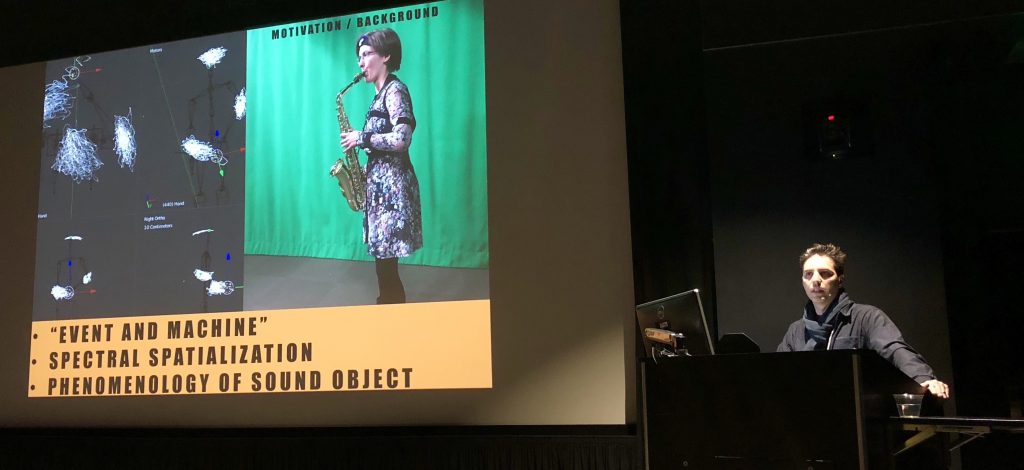Pia Tikka and Martin Jaroszewicz gave a joint talk at the CNA Sound and Storytelling Conference.
Image: Dr. Martin Jaroszewicz disucssing his ideas of enactive VR soundscapes at the Chapman University conference, Orange, CA, March 22.
“Enactive Virtuality – a framework for dynamically adaptive soundscapes”.
The novel notion of enactive virtuality is discussed, drawing from the theories of enactive mind [1], and the concept of enactive cinema [2]. The key attribute of ‘enactive’ refers here to the setting in which the human agent is in continuous feed-back-looped interaction with the surrounding world. Enactive virtuality in turn refers to the story emerging in the agent’s mind in this dynamical setting in order to make sense of the world. This story is based on the agent’s current situation and previous experiences [3], and in relation to others through neurally built-in imitation of their actions [4]. Thus, the concept of ‘enactive virtuality’ extends beyond the common techno-spatial buzzword of ‘virtual reality’. While virtual reality technologies allow platforms where the perception of sound events can be modulated algorithmically, we describe the human agent’s experience of a dynamically adaptive soundscape as an expression of enactive virtuality.Theories and techniques of sound transformations in the spectral domain [5,6,7] for this setting are discussed.
References:
[1] Varela F, Thompson E, Rosch E. 1991. Embodied Mind. Cambridge, MA: MIT Press.
[2] Tikka P. 2008. Enactive Cinema: Simulatorium Eisensteinense. PhD diss. Helsinki: Univ. Art and Design Publ.
[3] Heyes CM, Frith CD. The cultural evolution of mind reading. Science. 2014 Jun 20;344(6190):1243091. doi:10.1126/science.1243091.
[4] Gallese V, Eagle MN, Migone P. 2007. Intentional attunement: mirror neurons (…) J Am Psychoanal Assoc. 55(1):131-76.
[5] Jaroszewicz, M. 2015 Compositional Strategies in Spectral Spatialization. PhD thesis,University of California Riverside,
[6] Jaroszewicz, M. 2017 ”Interfacing Gestural Data from Instrumentalists,” ART – Music Review, vol. 32.
[7] Kim-Boyle. 2008. “Spectral spatialization – an overview,” RILM Abstracts of Music Literature. http://hdl.handle.net/2027/spo.bbp2372.2008.086